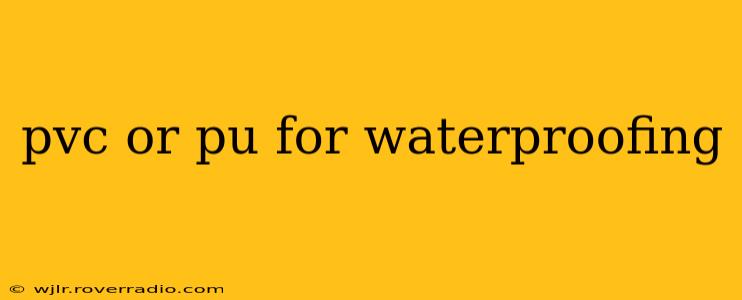Choosing the right waterproofing material is crucial for protecting your property from water damage. Polyvinyl chloride (PVC) and polyurethane (PU) are two popular choices, each with its own strengths and weaknesses. This guide will help you understand the key differences between PVC and PU waterproofing membranes to make an informed decision.
What is PVC Waterproofing?
PVC waterproofing membranes are flexible sheets made from polyvinyl chloride, a durable thermoplastic polymer. They're known for their high tensile strength, resistance to punctures, and excellent longevity. PVC membranes are often reinforced with polyester fabrics for added strength and tear resistance. They’re typically installed using hot air welding or adhesive bonding, creating a seamless waterproof barrier.
What is PU Waterproofing?
Polyurethane (PU) waterproofing is a liquid-applied membrane that cures to form a seamless, elastomeric coating. Unlike PVC, which comes in pre-fabricated sheets, PU is applied directly to the substrate. This allows for excellent adhesion to various surfaces and the ability to cover complex shapes and details. PU membranes are highly flexible and can accommodate movement in the substrate, making them suitable for areas prone to expansion and contraction.
PVC vs. PU: A Detailed Comparison
Here's a breakdown of the key differences to help you decide which material is best for your waterproofing needs:
Durability and Longevity:
Both PVC and PU membranes offer excellent durability. PVC membranes, particularly those reinforced with polyester, boast exceptional resistance to punctures and tears, resulting in a long lifespan, often exceeding 20 years. PU membranes also offer good durability, though their lifespan can vary depending on the quality of the product and the application conditions. Proper preparation and application are key to maximizing the lifespan of any waterproofing membrane.
Flexibility and Movement Accommodation:
PU membranes significantly outperform PVC in flexibility. Their elastomeric nature allows them to stretch and accommodate movement in the substrate without cracking or failing. This makes them ideal for waterproofing structures prone to expansion and contraction due to temperature changes or ground movement. PVC, while flexible, is less adaptable to significant movement.
Installation and Application:
PVC installation requires specialized skills and equipment, typically involving hot air welding or adhesive bonding. This can make it a more expensive and time-consuming process. PU, on the other hand, is a liquid-applied system, allowing for easier application on complex surfaces and details. However, proper surface preparation is crucial for successful PU application.
Cost:
The cost of PVC and PU waterproofing can vary depending on several factors, including material quality, labor costs, and project complexity. Generally, PU membranes can be more expensive initially due to the higher material cost, but the ease of application can sometimes offset this. PVC can be cost-effective for large, flat surfaces where its installation efficiency shines.
Maintenance:
Both PVC and PU membranes require minimal maintenance. Regular inspections for any signs of damage are recommended for both. Minor repairs are usually straightforward for both materials, but major repairs might require professional intervention.
Suitability for Different Applications:
- PVC: Best suited for flat roofs, balconies, terraces, and other areas with minimal movement. Its high puncture resistance makes it ideal for areas with potential foot traffic or exposure to sharp objects.
- PU: Well-suited for areas with complex geometries, movement, or expansion/contraction issues. Its flexibility makes it ideal for foundations, basements, and areas with significant substrate movement.
Frequently Asked Questions (PAA)
Here are some frequently asked questions about PVC and PU waterproofing:
Which is better for a flat roof?
For a flat roof, both PVC and PU can be effective. PVC's puncture resistance is advantageous, while PU's flexibility can better accommodate minor substrate movement. The choice depends on factors like the roof's size, expected foot traffic, and potential for movement.
Which is more environmentally friendly?
Both PVC and PU membranes have environmental impacts. PVC production involves the use of chlorine, and its disposal can be challenging. PU membranes are generally considered to have a lower environmental footprint, particularly some newer formulations with recycled content. Consider looking into eco-friendly options within both categories.
How long does each type of waterproofing last?
The lifespan of both PVC and PU membranes can vary. High-quality PVC membranes can last for 20 years or more, while PU membranes' lifespan depends on the quality of the material and application. Proper installation and regular maintenance are crucial for extending the lifespan of both types.
Which is easier to repair?
Minor repairs to both PVC and PU membranes can be relatively straightforward, though the methods differ. Larger repairs usually require professional intervention for both.
Which is better for a basement?
For basements, PU waterproofing is often preferred due to its flexibility and ability to conform to complex shapes and accommodate potential ground movement.
By carefully considering these factors and your specific project requirements, you can make an informed decision about whether PVC or PU is the best waterproofing solution for your needs. Remember to consult with a qualified waterproofing professional for advice tailored to your specific circumstances.
